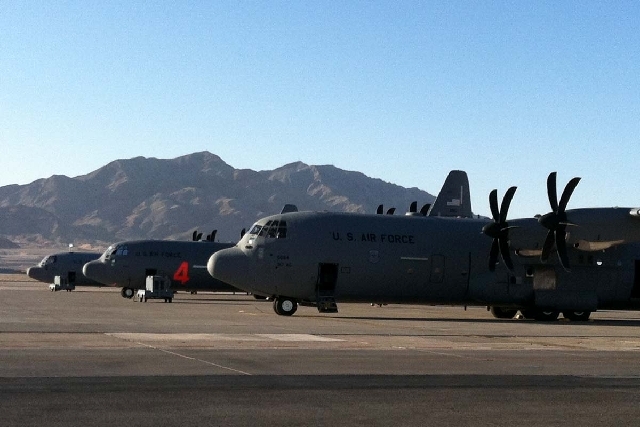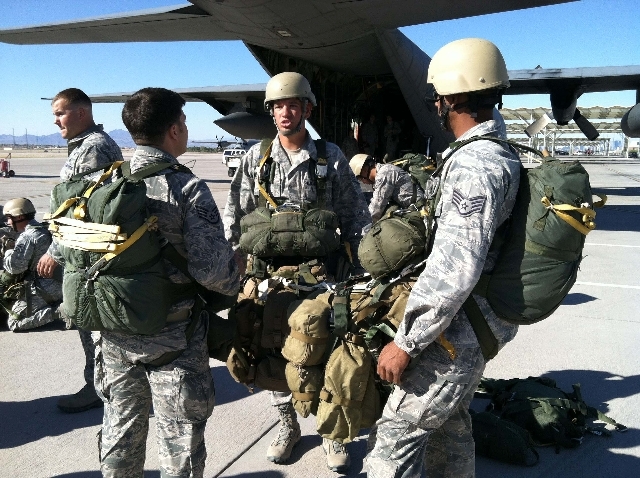Paratroopers take their final exam in Nevada desert


As the sun rose Friday over Nellis Air Force Base, Andrew Klodt waddled toward the rear ramp of a C-130 Hercules transport plane.
Like the other airmen in his column, he did what paratroopers call the “duck walk” to reach the open door of the behemoth, propeller-driven aircraft with a packed parachute on his back and a rucksack crammed with 40 pounds of gear strapped to his abdomen.
In an hour with the plane cruising at 1,250 feet over the remote Nevada Test and Training Range, the 27-year-old staff sergeant from Beardsley, Minn., would step out the back door hoping the chute opens. His thoughts before the flight were more about comfort than fear.
“I’m just waiting to get out of this,” he said.
As a member of 820th RED HORSE (Rapid Engineer Deployable Heavy Operational Repair Squadron Engineer) at Nellis, he was part of the team destined to land near a would-be enemy airfield that had been bombed by U.S. warplanes. Their job, using equipment cargo dropped ahead them, was to repair the airstrip so C-17 Globemaster transport planes could land on it and bring home soldiers and airmen from the battlefield.
It was all part of the final exam, known as the Joint Forcible Entry Exercise, for the Air Force Weapons School and the Army’s 82nd Airborne Division’s 3rd Brigade Combat Team.
And with the sequester budget ax forcing cancellation of the next graduate-level Weapons School for pilots, Friday’s exercise will be the last of its kind for this year. The mandatory, deficit-reduction measures have put the Air Force in a “tiered readiness” mode, making the lessons learned from this exercise with the Army even more significant.
“By bringing it together, we’re actually getting, I think, more bang to the training dollars we do have, not just for the Air Force and the Weapons School but also for the Army and the 82nd Airborne Division and the 18th Airborne Corps,” said Lt. Col. Brian Wald, a C-17 pilot and commander of the 57th Weapons Squadron.
In an interview on the Nellis flight line, he described the exercise in terms of using F-22 Raptors, F-15 Strike Eagles, A-10 Thunderbolts and F-16 Fighting Falcon jets for “peeling back layers of the onion, the enemy, so we can get these (transport) airplanes in so we can get the Army on the ground.”
In this case, the 82nd Airborne Division team deployed a special satellite antenna to provide communications and video streaming so leaders 3,000 miles away at Fort Bragg, N.C., can quickly see what’s happening on the battlefield.
“That’s how this is a little bit better than what we’ve done in the past,” Wald said.
“It seems like a baby step because there’s not necessarily more personnel involved or more airplanes involved but they’re getting more out of the airplanes and personnel that are here,” he said.
Dozens of C-17s and C-130s dropped equipment and paratroopers into “the fight,” as Wald put it. A few of the C-17s were sent from Pope Air Force Base, N.C., to deliver 60 of the top Airborne Rangers from Fort Bragg.
“Since they’re exercising command-and-control, they’re the battalion leadership, the senior guys,” Wald said. “They’re going out to get the ground command post ready and linked back to Fort Bragg so they can run the fight the way they want to run the fight.”
He said the “hard part for the Air Force is making sure that the conditions are ready for us to deliver the troops on the ground. Like I said, we can’t get in unless we peel back the onion, and the onion being the enemy. So we have an air-to-air pack that is going to go in and dismantle our adversary’s air force.”
Contact reporter Keith Rogers at krogers@reviewjournal.com or 702-383-0308.












